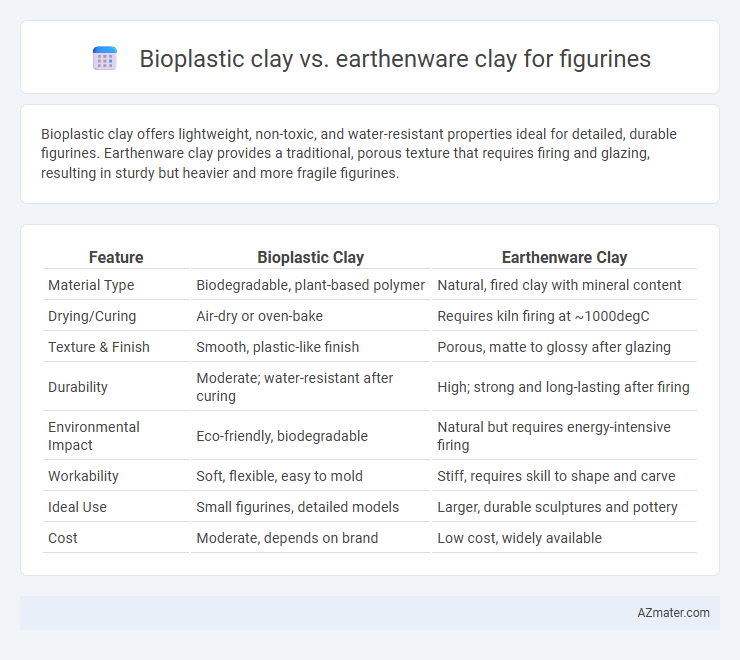Bioplastic clay offers lightweight, non-toxic, and water-resistant properties ideal for detailed, durable figurines. Earthenware clay provides a traditional, porous texture that requires firing and glazing, resulting in sturdy but heavier and more fragile figurines.
Table of Comparison
| Feature | Bioplastic Clay | Earthenware Clay |
|---|---|---|
| Material Type | Biodegradable, plant-based polymer | Natural, fired clay with mineral content |
| Drying/Curing | Air-dry or oven-bake | Requires kiln firing at ~1000degC |
| Texture & Finish | Smooth, plastic-like finish | Porous, matte to glossy after glazing |
| Durability | Moderate; water-resistant after curing | High; strong and long-lasting after firing |
| Environmental Impact | Eco-friendly, biodegradable | Natural but requires energy-intensive firing |
| Workability | Soft, flexible, easy to mold | Stiff, requires skill to shape and carve |
| Ideal Use | Small figurines, detailed models | Larger, durable sculptures and pottery |
| Cost | Moderate, depends on brand | Low cost, widely available |
Introduction: Bioplastic Clay vs Earthenware Clay for Figurines
Bioplastic clay offers a lightweight, non-toxic, and air-dry alternative ideal for detailed figurine crafting, providing flexibility and ease of use without the need for kiln firing. Earthenware clay, composed of natural clay fired at lower temperatures, delivers durability and a traditional ceramic finish suitable for functional and decorative figurines but requires kiln firing and longer drying times. Choosing between bioplastic and earthenware clay depends on the desired finish, firing requirements, and the project's time constraints.
Material Composition and Sustainability
Bioplastic clay, derived from natural polymers such as cornstarch and cellulose, offers a biodegradable and non-toxic alternative to traditional earthenware clay, which primarily consists of natural clays layered with silica and alumina. Unlike earthenware clay that requires high-temperature kiln firing, bioplastic clay air-dries, reducing energy consumption and carbon footprint during production. The sustainable composition of bioplastic clay aligns with eco-friendly practices by minimizing plastic waste and promoting compostability, whereas earthenware clay, while natural, demands significant resource-intensive processing.
Workability and Sculpting Techniques
Bioplastic clay offers superior workability due to its lightweight, flexible texture and extended drying time, making it ideal for intricate sculpting techniques like fine detailing and layering. Earthenware clay, while denser and more prone to cracking during drying, provides a traditional sculpting experience suited for coiling and pinching methods, with a natural, earthy finish after firing. Choosing between bioplastic and earthenware clay depends on desired sculptural precision and the preferred drying or firing process.
Drying and Curing Processes
Bioplastic clay typically air-dries within 24 to 48 hours, requiring no additional heat treatment, making it ideal for quick projects and beginners. Earthenware clay demands slow, controlled drying to prevent cracking, followed by kiln firing at temperatures between 1,000degC and 1,150degC to achieve durability and finished hardness. The drying phase for earthenware can span days to weeks depending on thickness, while bioplastic clay's curing process is significantly shorter and less complex.
Strength and Durability of Finished Figurines
Bioplastic clay offers higher strength and durability for finished figurines due to its polymer composition, making it less prone to cracking and breaking compared to earthenware clay. Earthenware clay, being porous and fired at lower temperatures, results in more fragile figurines that require sealing for enhanced longevity. Strength and impact resistance are significantly better in bioplastic clay figurines, ensuring greater resilience during handling and display.
Surface Finish and Detailing Potential
Bioplastic clay offers a smooth, pliable surface ideal for intricate detailing and fine textures in figurine making, allowing for precise sculpting and cleaner lines. Earthenware clay has a rougher texture that can enhance rustic or natural finishes but may limit ultra-fine detail due to its coarser grain and variable drying properties. Surface finish on bioplastic clay remains consistent after curing, while earthenware clay requires careful firing to avoid surface imperfections and achieve desired glaze effects.
Painting and Decoration Compatibility
Bioplastic clay offers excellent surface smoothness and flexibility, allowing for intricate painting and the use of a variety of decorative finishes such as acrylics and varnishes without cracking. Earthenware clay, being porous and less flexible once fired, requires sealing before painting to prevent paint absorption and often necessitates specialized ceramic glazes for vibrant, durable decoration. Choosing between bioplastic and earthenware clay for figurines impacts the types of paints and sealants compatible with the finished piece, influencing both aesthetic options and long-term durability.
Environmental Impact and Biodegradability
Bioplastic clay offers a significantly lower environmental impact compared to traditional earthenware clay due to its organic, renewable materials and compostable nature, which enables faster biodegradability. Earthenware clay, while natural, often requires high-temperature kiln firing that consumes considerable energy and produces CO2 emissions, slowing its overall environmental benefits. Bioplastic clay's biodegradable properties make it a sustainable choice for eco-friendly figurines, whereas earthenware clay remains less sustainable due to its energy-intensive processing and longer decomposition time.
Cost and Availability Comparison
Bioplastic clay typically costs more than earthenware clay due to its eco-friendly materials and manufacturing process, but it is widely available in specialty craft stores and online. Earthenware clay is generally less expensive and more accessible, found in most art supply or pottery shops, making it a budget-friendly option for figurine creation. While bioplastic clay offers sustainable benefits, earthenware clay remains the preferred choice for cost-conscious artists seeking easy local sourcing.
Best Applications: Which Clay Suits Your Figurine Project?
Bioplastic clay offers excellent flexibility and durability, making it ideal for detailed, lightweight figurines that require fine sculpting and easy painting. Earthenware clay, known for its natural texture and robust firing properties, suits rustic or traditional figurines intended for outdoor display or practical use. For intricate, decorative pieces, bioplastic clay excels, while earthenware clay is preferred for more substantial, long-lasting creations.

Infographic: Bioplastic clay vs Earthenware clay for Figurine
 azmater.com
azmater.com